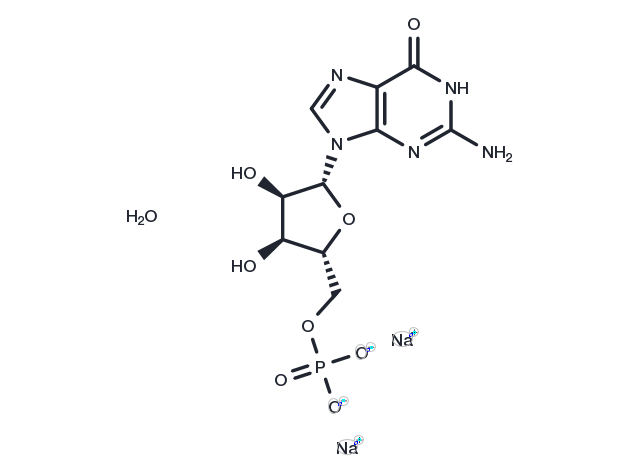Powder: -20°C for 3 years | In solvent: -80°C for 1 year


5'-Guanylic acid disodium salt (GMP-5) belongs to the class of organic compounds known as purine ribonucleoside monophosphates. In particular, L-Glutamic acid and guanosine monophosphate can be biosynthesized from xanthylic acid and L-glutamine; which is catalyzed by the enzyme GMP synthase [glutamine-hydrolyzing]. In addition, Guanosine triphosphate and guanosine monophosphate can be biosynthesized from diguanosine tetraphosphate; which is catalyzed by the enzyme bis(5'-nucleosyl)-tetraphosphatase [asymmetrical]. In humans, guanosine monophosphate is involved in the kanamycin action pathway, the telithromycin action pathway, the tobramycin action pathway, and the erythromycin action pathway. Guanosine monophosphate is also involved in several metabolic disorders, some of which include the AICA-ribosiduria pathway, adenosine deaminase deficiency, adenine phosphoribosyltransferase deficiency (aprt), and the 2-hydroxyglutric aciduria (D and L form) pathway. Outside of the human body, guanosine monophosphate can be found in a number of food items such as onion-family vegetables, millet, chinese water chestnut, and red rice. This makes guanosine monophosphate a potential biomarker for the consumption of these food products.

| Pack Size | Availability | Price/USD | Quantity |
|---|---|---|---|
| 100 mg | In stock | $ 41.00 |



| Description | 5'-Guanylic acid disodium salt (GMP-5) belongs to the class of organic compounds known as purine ribonucleoside monophosphates. In particular, L-Glutamic acid and guanosine monophosphate can be biosynthesized from xanthylic acid and L-glutamine; which is catalyzed by the enzyme GMP synthase [glutamine-hydrolyzing]. In addition, Guanosine triphosphate and guanosine monophosphate can be biosynthesized from diguanosine tetraphosphate; which is catalyzed by the enzyme bis(5'-nucleosyl)-tetraphosphatase [asymmetrical]. In humans, guanosine monophosphate is involved in the kanamycin action pathway, the telithromycin action pathway, the tobramycin action pathway, and the erythromycin action pathway. Guanosine monophosphate is also involved in several metabolic disorders, some of which include the AICA-ribosiduria pathway, adenosine deaminase deficiency, adenine phosphoribosyltransferase deficiency (aprt), and the 2-hydroxyglutric aciduria (D and L form) pathway. Outside of the human body, guanosine monophosphate can be found in a number of food items such as onion-family vegetables, millet, chinese water chestnut, and red rice. This makes guanosine monophosphate a potential biomarker for the consumption of these food products. |
| Synonyms | Guanosine 5'-monophosphate disodium salt, GMP-5 |
| Molecular Weight | 425.2 |
| Formula | C10H14N5Na2O9P |
| CAS No. | 5550-12-9 |
Powder: -20°C for 3 years | In solvent: -80°C for 1 year
H2O: 10 mM
DMSO: Insoluble
You can also refer to dose conversion for different animals. More
bottom
Please see Inhibitor Handling Instructions for more frequently ask questions. Topics include: how to prepare stock solutions, how to store products, and cautions on cell-based assays & animal experiments, etc.
5'-Guanylic acid disodium salt 5550-12-9 Metabolism Others Endogenous Metabolite 5'-guanosine monophosphate disodium Inhibitor 5'-Guanylic acid 5'-GMP disodium 1333479 Guanosine 5'-monophosphate disodium salt 5'Guanylic acid disodium salt Guanosine 5'-monophosphate Guanosine 5'-monophosphate disodium GMP5 inhibit GMP-5 GMP 5 5' Guanylic acid disodium salt 5'-Guanylic acid disodium inhibitor
